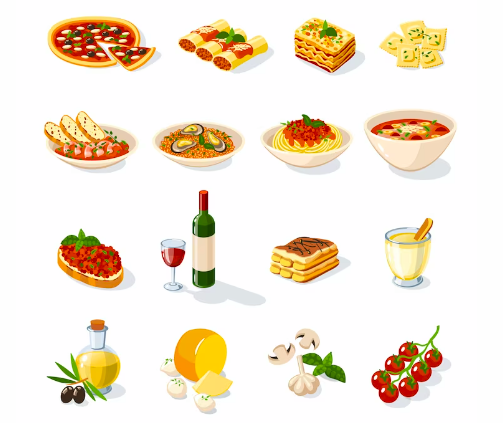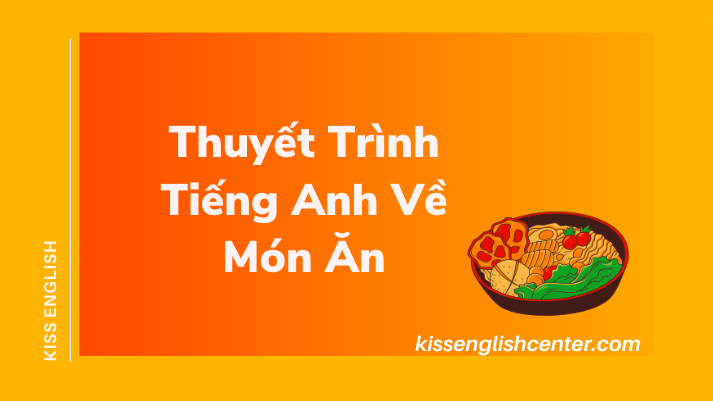Thuyết Trình Tiếng Anh Về Món Ăn 2023
Trong bài viết này, KISS English sẽ cùng các bạn tìm hiểu cách thuyết trình tiếng anh về món ăn. Hãy theo dõi nhé.
Xem ngay bí quyết thuyết trình tiếng anh hay tại đây nhé:
Video hướng dẫn bí quyết thuyết trình tiếng Anh hay – Ms Thuy KISS English
Chủ đề món ăn là một chủ đề rất thường gặp trong các bài speaking lẫn writing tiếng Anh. Trong bài viết này, KISS English sẽ cùng các bạn tìm hiểu cách thuyết trình tiếng anh về món ăn nhé.
Nội dung:
Bố Cục Bài Thuyết Trình Tiếng Anh Về Món Ăn

Introduction
Tổng quan về món ăn: Giới thiệu món ăn mà bạn sẽ thảo luận. Đặt trong bối cảnh văn hóa và ẩm thực của quốc gia hoặc vùng miền nơi món ăn này xuất xứ.
Ví dụ: There are many delicious dishes in Vietnam, but one of my favorite dishes is Banh Mi which originated from Ho Chi Minh City.
(Có rất nhiều món ăn ngon ở Việt Nam nhưng một trong những món ăn ưa thích của tôi đó là Bánh Mì – một món ăn bắt nguồn từ TP Hồ Chí Minh. )
Body:
Mô tả chi tiết món ăn:
- Trình bày các nguyên liệu chính và quá trình chế biến của món ăn.
- Miêu tả từng bước quan trọng trong việc chuẩn bị và nấu món ăn.
- Mô tả hương vị và mùi thơm đặc trưng.
Lý do yêu thích món ăn:
- Chia sẻ tại sao món ăn này đặc biệt và quan trọng trong văn hóa và ẩm thực địa phương.
- Đề cập đến sự phong phú về hương vị, giá trị dinh dưỡng hoặc những câu chuyện liên quan đến món ăn.
Conclusion:
Tóm tắt lại những điểm quan trọng về món ăn và kết thúc bài thuyết trình.
Lưu ý: Quan trọng nhất là sắp xếp nội dung theo một trình tự logic và rõ ràng, đồng thời sử dụng ngôn ngữ mạch lạc và truyền đạt đầy đủ thông tin cần thiết về món ăn mà bạn đang giới thiệu.
Mẫu Bài Thuyết Trình Tiếng Anh Về Món Ăn

Mẫu 1: Beef Noodles – Pho Bo
Vietnamese cuisine is renowned for its vibrant flavors and aromatic dishes, and one iconic dish that encapsulates the essence of this culinary heritage is Beef Noodles, or “Pho Bo” in Vietnamese. A steaming bowl of Pho Bo is a quintessential comfort food that has captivated taste buds around the world.
- Origins and History:
Beef Noodles traces its roots back to Northern Vietnam, specifically Hanoi, where it emerged as a popular street food in the early 20th century. It was initially enjoyed by workers and merchants who sought a nourishing and inexpensive meal. Over time, Pho Bo gained popularity throughout the country and eventually spread globally, becoming a symbol of Vietnamese cuisine.
- Key Ingredients and Broth:
At the heart of Pho Bo lies its soulful broth, which is painstakingly prepared by simmering beef bones, aromatic spices such as star anise, cloves, and cinnamon, and charred onions and ginger for several hours. This slow-cooking process extracts all the savory goodness, resulting in a rich and fragrant broth that forms the dish’s foundation.
The dish also features thinly sliced beef, often cuts like brisket or flank steak, which are added to the bowl just before serving. The heat of the broth gently cooks the beef, rendering it tender and retaining its natural flavors.
- Rice Noodles and Toppings:
Pho Bo is traditionally served with banh pho, flat rice noodles that are cooked to perfection and added to the bowl alongside the beef. These noodles provide a delightfully chewy texture and serve as a vessel for the flavorsome broth. Various toppings and garnishes are then added to enhance the taste and add complexity to the dish. Common toppings include fresh bean sprouts, fragrant Thai basil leaves, zesty lime wedges, fiery bird’s eye chili, and pungent cilantro. These ingredients contribute to the visual appeal and provide a burst of freshness and aroma.
- Dining Experience and Accompaniments:
Eating Pho Bo is an immersive experience. The steaming bowl of fragrant broth and the comforting aroma of herbs and spices create an anticipation met with each savory spoonful. Diners can customize their Pho Bo by adding condiments like hoisin sauce, sriracha, or fish sauce according to their preferences. Pho Bo is often enjoyed alongside a side plate of fresh herbs, lime wedges, and chili, allowing diners to personalize their bowls further. A bowl of Pho Bo is best enjoyed with chopsticks for maneuvering the noodles and beef and a soup spoon for savoring the flavorsome broth.
With its delicate balance of flavors and comforting qualities, Beef Noodles has become an international sensation, representing the essence of Vietnamese cuisine. Its enduring popularity can be attributed to its complex yet harmonious taste profile, nourishing qualities, and the sense of culinary adventure it offers to those who partake in its pleasures. So, the next time you have the opportunity to savor a steaming bowl of Pho Bo, take a moment to appreciate the artistry and cultural significance that this dish embodies.
Mẫu 2: Bún thịt nướng
Vietnam is a country rich in culinary traditions, with diverse flavors and dishes that tantalize the taste buds. Among the many beloved Vietnamese delicacies, bún thịt nướng stands out as a vibrant and mouthwatering dish. With its combination of grilled marinated meat, fresh herbs, vermicelli noodles, and a medley of flavors, bún thịt nướng offers a sensory journey through the vibrant streets of Vietnam. Today, we will delve into the captivating flavors, unique ingredients, and cultural significance of this iconic Vietnamese dish, which has captured the hearts and palates of people around the world.
- Flavors and Ingredients:
Bún thịt nướng is a harmonious blend of flavors that creates a perfect balance of sweet, savory, sour, and refreshing tastes. The star ingredient, thịt nướng, refers to marinated and grilled pork seasoned with a combination of garlic, lemongrass, fish sauce, and other aromatic spices. The grilling process imparts the meat a smoky and charred flavor, adding depth to every bite. The dish is then served with a bed of vermicelli rice noodles, fresh lettuce, bean sprouts, cucumber, and fragrant herbs such as mint, cilantro, and Thai basil. The final touch is the dressing, typically a fish sauce-based mixture infused with lime juice, garlic, chili, and a hint of sweetness. When all these components come together, bún thịt nướng creates a symphony of flavors that captivate the palate.
- Cultural Significance:
Beyond its delectable taste, bún thịt nướng holds cultural significance in Vietnamese cuisine and everyday life. It is a popular street food dish that can be found in bustling markets and street stalls across Vietnam. Its accessibility and affordability make it a beloved choice for locals and visitors alike. Bún thịt nướng is often enjoyed as a light and satisfying meal, reflecting the Vietnamese emphasis on fresh ingredients and balanced flavors. It also embodies the Vietnamese dining culture of communal eating, as it is typically served with various condiments and herbs that allow each person to customize their bowl according to their preferences.
In conclusion, bún thịt nướng is a culinary masterpiece that represents the essence of Vietnamese cuisine. Its vibrant flavors, the marriage of grilled pork and fresh herbs, and the interplay of textures make it an unforgettable dining experience. Beyond its gustatory pleasures, bún thịt nướng carries the cultural heritage of Vietnam, reflecting the country’s love for bold flavors, communal dining, and the use of fresh, aromatic ingredients. So, the next time you have the opportunity to savor this iconic Vietnamese dish, indulge in the symphony of flavors and immerse yourself in the rich culinary tapestry of Vietnam.
Lời Kết
Trên đây là những thông tin về cách thuyết trình tiếng anh về món ăn mà KISS English muốn đem đến cho bạn. Hy vọng bài viết này phù hợp và bổ ích với bạn. Chúc bạn có một buổi học vui vẻ và hiệu quả.
Ăn không chỉ có Eat, dùng 10 cụm từ này để lên trình nói tiếng Anh bạn nhé:
15 Từ Vựng Tiếng Anh Về Đồ Ăn Cần Biết Cho Mọi Cuộc Trò Chuyện:

